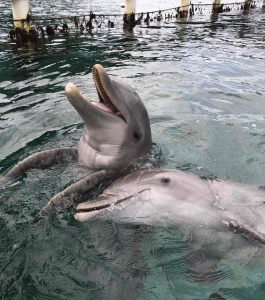
We just finished dinner, which was preceded by our first ever, collectively night snorkel. Some of us were lucky enough to see a lionfish or an octopus or a sea cucumber! We also saw a puffer fish. We entered the water at dusk and then exited when it was fully dark. It was eerie and surreal at the same time.
The afternoon had a break before our night snorkel that allowed some of us to kayak or paddleboard … or nap. This break was after our informal lecture at the pool about how dolphin calves swimming in echelon position swim faster with fewer fluke strokes to cover longer distances than calves swimming independently (from Noren et al. 2008). It was a lively discussion.
We were much more confident in our recognition of Champ and a few of the other dolphins (e.g., Tilly) from this morning’s video data. It was cool to see Sandy swimming more in infant position, which matched up to the article we were reading about calf swimming position. We watched the video after the sea turtle lecture from Jenn at RIMS.
Our first lecture in the afternoon was about sea turtles. We learned that leatherback sea turtles don’t have a hard shell which allows them to dive to depths of 2,000 feet to eat jellies. We also learned about the Arribada in Ostional, Costa Rica, where locals are allowed to harvest Olive Ridley sea turtle eggs over a two-day period once a year. Green sea turtles are called green because their fat is colored green.
Lunch was midday and we learned that pasta salad was pasta over lettuce not just pasta. It was still tasty.
Our late morning saw us collecting space use data during a dolphin encounter and a dolphin swim at Bailey’s Key. It was really awesome to have Kathleen on the dock with us during the observations so we could really cement our understanding of the activity levels and recognizing dolphins. We have a clearer understanding of documenting activity levels. We got more comfortable with our groups, too. And, we got to see some neat behaviors (e.g., leaps and back tail walks) that we’d not seen before during our observations.
We had a morning break to read the paper for the afternoon discussion session and breakfast was between this break and data collection in the early morning with Kathleen. We got WET! There was a double rainbow and a full rainbow in the sky, which was a lovely way to say so-long to the deluge of rain that drenched all of us as we collected space use data. We did not realize who of the dolphins were trying to play with us until we watched the video and confirmed the specific scars and rake marks to facilitate recognition via natural marks.
So, tomorrow, we hope to break our AM streak and have no rain!
Until tomorrow,
Kathleen and the URI team!
